NEW PROFESSORS
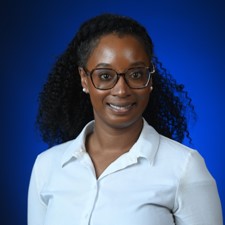
Dr. Sharday Ewell

Dr. Lydia Lytal

Dr. Timothy Menzel

Dr. Mariel Pfeifer

Dr. Rebecca Prescott
NEW STAFF
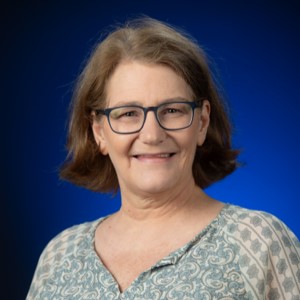
Catherine Hultman
Operations Manager
RETIREMENTS

Dr. Brian Doctor

Dr. Cliff Ochs

Dr. Glenn Parsons

Dr. Sharday Ewell

Dr. Lydia Lytal

Dr. Timothy Menzel

Dr. Mariel Pfeifer

Dr. Rebecca Prescott

Catherine Hultman
Operations Manager

Dr. Brian Doctor

Dr. Cliff Ochs

Dr. Glenn Parsons
Christian Boudreaux
Noah Garrett
Alyssa Stoner
Logan Thomas
Brady Bass
Destiny Kirksey
Daniel Cuenca
Kayla Morgan
Simon Nguyen
Trent Smith
Jessy Gardner
Graci Porter
Grace Thompson
Camryn White
Gabrielle Morris
Zynub Al-Sherri
Thomas Berry
Sarah Brownlee
Andrea Cleveland
Rylie Mangold
Anna Robertson
Alyssa Stoner
Nicole Jones published “Sleep Duration is Associated with Caudate Volume and Executive Function” in Brain Imaging and Behavior’s Online Edition
Josh Rangel – MS, Summer 2022 – Advisor: Dr. Glenn Parsons
Laura West – MS, Summer 2022 – Advisor: Dr. Lainy Day
Clement Agyemang – MS, December 2022 – Advisor: Dr. Brad Jones
Ruric Bowman – MS, Spring 2023 – Advisor: Dr. Chris Leary
Griffin Williams – Ph.D., Spring 2023 – Advisor: Dr. Steve Brewer
Xia Li – Ph.D., Summer 2023 – Advisor: Dr. Erik Hom
Savannah Draud – Ph.D., featured on Good Things on SuperTalkTV for her outreach program to public schools. https://youtu.be/odfgwksdcCQ
Matthew Thibodeaux – MS, – Advisor: Dr. Lainy Day
Patrick Allison – Ph.D., – Advisor: Dr. Ryan Garrick
Jessi Stamn – Ph.D., – Advisor: Dr. Richard Buchholz
Laney Nute – Ph.D., – Advisor: Dr. Richard Buchholz
Kayleigh Mazariegos – Ph.D., – Advisor: Dr. Richard Buchholz
Laney Nute – Ph.D., – Advisor: Dr. Richard Buchholz
Sara Lucia Anaya Morales – Ph.D., – Advisor Dr. Michel Ohmer
Alicia Arrington-Thomas – Ph.D., – Advisor: Dr. Steve Brewer
Prabin Dawadi – Ph.D., – Advisor: Dr. Erik Hom
Sara Lucia Anaya Morales – Ph.D., – Advisor: Dr. Michel Ohmer
Bowen Tan – Ph.D., – Advisor: Dr. Sixue Chen
Prashanna Koirala – Ph.D., – Advisor: Dr. Joshua Bloomekatz
Harini Saravanan – Ph.D., – Advisor: Dr. Joshua Bloomekatz
Anupa Wasti Thapaliya – Ph.D., – Advisor: Dr. Yongjian Qiu
Sabnam Ojha – Ph.D., – Advisor: Dr. Sarah Liljegren
Gayatri Sharma – Ph.D. – Advisor: Dr. Patrick Curtis
Madleyn Jewess – MS, – Advisor: Dr. Steve Brewer
Rabina Shrestha – Ph.D., – Advisor: Dr. Joshua Bloomekatz
Tahmina Akter – Ph.D., – Advisor: Dr. Sixue Chen
Laney Nute – Ph.D., – Advisor: Dr. Richard Buchholz
Savanna Draud – Ph.D., – Advisor: Dr. Jason Hoeksema
Maddie Jewess – MS, – Advisor: Dr. Steve Brewer
Kayleigh Mazariegos – Ph.D., – Advisor: Dr. Richard Buchholz
Abhishesh Bajracharya – Ph.D., – Advisor: Dr. Yongjian Qiu
Dr. Jason Hoeksema
Dr. Becky Symula
Dr. Carol Britson
Dr. Joshua Schmerge
Dr. Richard Buchholz featured in UMToday “Biologist, Students Promote Research on Sustainable Ecotourism” September 2022
Dr. Jason Hoeksema featured in New York Times’ “Are Trees Talking Underground? For Scientists, It’s in Dispute” published November 7, 2022
Dr. Erik Hom’s “Mutualism-Enhancing Mutations Dominate Early Adaptation in a two-species Microbial Community,” published in Nature Ecology and Evolution January 2023
Dr. Mika Jekabsons’ “Breast Cancer Cells that Preferentially Metastasize to Lung or Bone are More Glycolytic, Synthesize Serine at Greater Rates, and Consumes Less ATP and NADPH than Parent MDA-MB-231 Cells” published in BMC journal January 2023
Dr. Jason Hoeksema’s “Positive Citation Bias and Overinterpreted Results Lead to Misinformation on Common Mycorrhizal Networks in Forests” published in Nature Ecology and Evolution February 2023
Dr. Yongjian Qiu presents “Reveal the Internal Networking of Plant Thermal Responses Using Microdevices” at TEDX Conference hosted at the Ford Center, University of Mississippi February 23, 2023
Dr. Patrick Curtis received 2022 Outstanding Article for “The Transcriptional Regulator CtrA Controls Gene Expression in Alphaproteobacteria Phages: Evidence for a Lytic Deferment Pathway” published in Frontiers in Microbiology
Dr. Tamar Goulet coauthored “Building Consensus Around the Assessment and Interpretation of Symbiodiniaceae Diversity” published in PeerJ March 2023
Dr. Clifford Ochs’ “Rivers of the Lower Mississippi Basin,” published in chapter six in Rivers of North America, volume 2
Dr. Ryan Garrick appeared on Henry Stewart Talks and presented “Principles of Phylogeography and Landscape Genetics” that was broadcast April 30, 2023 Principles of phylogeography and landscape genetics | HSTalks
Dr. Steve Brewer and Dr. Jason Hoeksema co-hosted “Invasions and Ecosystems-Ecosystem Functional Consequences of Plant and Fungal Invasions, and How Dynamics and Management of Invasions are Affected by Global Change and Extreme Climatic Events” at Hawkesbury Institute for the Environment at Western Sydney University in Australia from May 15-28, 2023
Dr. Tamar Goulet and Dr. Colin Jackson coauthored “Systematic Review of Cnidarian Microbiomes Reveals Insights into the Structure, Specificity, and Fidelity of Marine Associations” and the manuscript has been accepted
Dr. Yongjian Qiu
Dr. Joshua Bloomekatz
Dr. Sixue Chen
Dr. Colin Jackson
Dr. Richard Buchholz with
Jessi Stamn, Lance Yarbrough,
Yili Jiang
Dr. Lainy Day promoted to rank of Full Professor
Dr. Jenny Cocciardi – Advisor: Dr. Michel Ohmer
Tyler Flynn, Gwen Rogers, Candece Stewart, Lance Sullivan, Adam Thebeau
October 2022 Open House accompanied by Shoemaker’s 1st haunted lab
April 2023 Earth Day at Avent Park assisted in part by Dr. Steve Brewer
May 2, 2023 Multicultural Night hosted by BGSS at Thad Cochran Research Center

Dr. Peter Zee, an evolutionary ecologist with a PhD from Indiana University. His research interests are in the evolution of species interactions in ecological communities.
![]() Ecology is a diverse field of study in biology, ranging from mathematical models to surveys in the field. Through a combination of lectures, computer labs, and field labs around the Oxford area, students learn how interactions between organisms and their environments result in the patterns of biodiversity around us. The course also focuses on helping students learn to interpret graphical information and data, skills that are useful across a wide array of careers. Applications of ecological thinking to human health, agricultural systems, and management of natural resources. Through the activities in this course, students will come away with an enriched view of the environment around them.
Ecology is a diverse field of study in biology, ranging from mathematical models to surveys in the field. Through a combination of lectures, computer labs, and field labs around the Oxford area, students learn how interactions between organisms and their environments result in the patterns of biodiversity around us. The course also focuses on helping students learn to interpret graphical information and data, skills that are useful across a wide array of careers. Applications of ecological thinking to human health, agricultural systems, and management of natural resources. Through the activities in this course, students will come away with an enriched view of the environment around them.
“Dr. Zee is cash money. He’s the best professor ever.”
“Dr. Zee has made this semester super easy and interesting. The thing I liked the most was on the first day of class, he made sure to show his students how Ecology was applicable from being an ecologist to how it’s used in the medical field. It helped me stay focused in the class and enjoy the material more.”
“I really enjoyed this class. It was all very interesting, and you begin to see the world around you a little differently. I think even if you aren’t the biggest fan of Ecology, you will find this course interesting.”

The field of biology has recently undergone a revolution and explosion in imaging capabilities. We can now see cellular and microscopic events at unprecedented temporal and spatial scales. These advancements have affected a wide-array of biological disciplines, reflecting the broad scope of the Department of Biology at UM.
![]() Dr. Joshua Bloomekatz, who earned his Ph.D. in Genetics at Weill Cornell Graduate School of Medical Sciences in NYC, introduces students in the Cell Imaging course to the conceptual and practical aspects of the wide variety of modern light microscopes — from stereoscopes to super-resolution imaging techniques.
Dr. Joshua Bloomekatz, who earned his Ph.D. in Genetics at Weill Cornell Graduate School of Medical Sciences in NYC, introduces students in the Cell Imaging course to the conceptual and practical aspects of the wide variety of modern light microscopes — from stereoscopes to super-resolution imaging techniques.
In particular we focus on the theoretical and practical aspects of confocal microscopy, the workhorse of modern cell biology laboratories. This focus includes training on the department’s advanced confocal microscope, a Lecia TCS SP8 X, with a white light laser. Students actively engage in all aspect of this course, which includes an imaging research project of the students’ own design involving the confocal microscope. Students also learn important skills related to experimental design as well as image processing and analysis. The important technical and conceptual skills taught in this class will help students succeed in biomedical and health science careers.
“I got time on confocal. Great microscope demos. Dr. Bloomekatz was fair and wanted students to succeed, but made you work for it in a positive way. ‘individual project’ component of course was nice; some real, hands on science.”
“Overall, this was a very informative and interesting class. Having not known much about the field of microscopy in general, I learned quite a bit about the different areas of microscopy and how to use the confocal microscope. This is a great skill to obtain.”

Dr. Lainy Day received her PhD from the University of Texas in Austin and completed postdoctoral research at the University of California Santa Barbara; James Cook University in Townsville, QLD, Australia; and the University of California Los Angeles. Her areas of research include behavioral neuroscience, neuroplasticity, evolution of cognition and motor-learning.
![]() This course is an introduction to how nerve cells work singly and in concert to guide the behavior of animals. We will take a comparative approach to understand how brains have evolved to allow animals to perceive stimuli, adopt particular mating strategies, learn and guide behavior, and communicate. We will also talk about variation in individual animals abilities to cope with a range of environmental and social stimuli by means of learning and epigenetics.
This course is an introduction to how nerve cells work singly and in concert to guide the behavior of animals. We will take a comparative approach to understand how brains have evolved to allow animals to perceive stimuli, adopt particular mating strategies, learn and guide behavior, and communicate. We will also talk about variation in individual animals abilities to cope with a range of environmental and social stimuli by means of learning and epigenetics.
“It is a great class. Fascinating topic, lots of information, awesome professor who wants you to succeed.”
“This class is amazing and so interesting. Day is a really good instructor and wants to see her students succeed. This is a great biology elective to take! 10/10”
“Dr. Day is very knowledgeable about neuroscience and is very approachable when it comes to you needing help outside of class. By far the BEST biology professor thus far….ever”

Dr. Susan Balenger received her Ph.D. at Auburn University and was a postdoctoral researcher in the Division of Genetics and Physiology at the University of Turku in Finland, and at the University of Minnesota. Her research addresses why and how environmental stressors and phenotypic plasticity influence sexual signal evolution and population divergence. In the Balenger lab research activities utilize genetics and genomics approaches, laboratory experimental manipulations, and field observations of natural populations.
![]() In recent years there has been an unprecedented rise in the global incidence and severity of infectious diseases in human, animal, and plant populations across nearly all of the world’s terrestrial, aquatic, and marine ecosystems. At the same time, the ways in which we approach the prevention and management of diseases have changed little in the past 50-100 years. It is becoming increasingly clear that the intensification of diseases around the world is, in part, due to human activities, which have brought about habitat transformation, biological invasions, environmental contamination, climate change, and ensuing losses of biodiversity. Although disease outbreaks have historically been studied in relative isolation, the ecological complexities of disease development and spread have been clearly illustrated by such famous examples as the plague, smallpox, and flu epidemics, the Irish potato blight, and more recently, the swine flu epidemic, amphibian chytridiomycosis, white nose disease of bats, Tasmanian devil facial tumor disease, bee colony collapse disease, various forest declines, SARS, Lyme disease, West Nile virus and Zika virus.
In recent years there has been an unprecedented rise in the global incidence and severity of infectious diseases in human, animal, and plant populations across nearly all of the world’s terrestrial, aquatic, and marine ecosystems. At the same time, the ways in which we approach the prevention and management of diseases have changed little in the past 50-100 years. It is becoming increasingly clear that the intensification of diseases around the world is, in part, due to human activities, which have brought about habitat transformation, biological invasions, environmental contamination, climate change, and ensuing losses of biodiversity. Although disease outbreaks have historically been studied in relative isolation, the ecological complexities of disease development and spread have been clearly illustrated by such famous examples as the plague, smallpox, and flu epidemics, the Irish potato blight, and more recently, the swine flu epidemic, amphibian chytridiomycosis, white nose disease of bats, Tasmanian devil facial tumor disease, bee colony collapse disease, various forest declines, SARS, Lyme disease, West Nile virus and Zika virus.
In this course students examine and discuss current concepts and trends in infectious disease biology, assessing our basic understanding of human and wildlife diseases and their impacts on one another. On a most basic level, this is a class based around problem solving and critical thinking. We will focus on problems related to the ecological and evolutionary processes that drive the transmission of pathogens between hosts; the impact of disease on host populations; and what causes the emergence of an infectious disease. The course content includes a theoretical framework and extensive discussion of wildlife and human diseases.
“Dr. Balenger is one of the best professors at this university. She’s funny and really cares about her students and wants them to learn. You can go to her office at any time to talk about class or other struggles you’re having. The class was very interesting and I feel like I still learned a lot because it was discussion based. All in all…an amazing class and would take again.”
“I had a great experience with this class. I feel like I learned more here than in many classrooms; particularly, I learned how to better express my thoughts in an intellectual discussion with my peers. I really enjoyed the opportunity to read scientific journals as the text for this class. If you like discussing science, this is the class for you!”
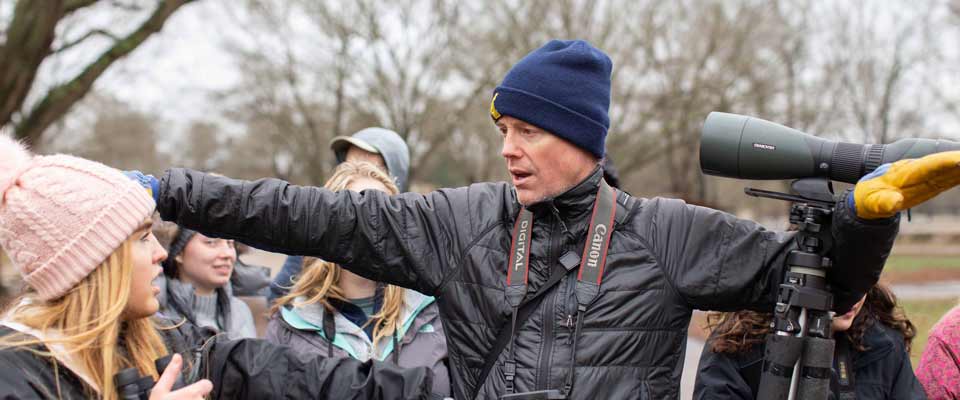
Dr. Jason Hoeksema, an ecology expert with a Ph.D. from the University of California, Davis, teaches Ornithology. The course introduces students to all aspects of the biology of birds — development, anatomy, physiology, behavior, ecology, evolution, systematics, field identification, and conservation — through a combination of lectures, laboratory exercises, and field trips. Field trips teach students to recognize how particular bird species depend on unique habitats, and students learn to identify dozens of bird species by sight and sound.
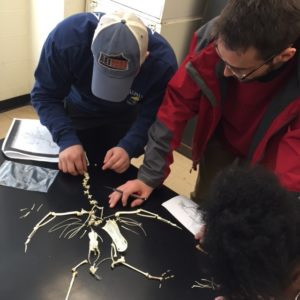 Ornithology helps to prepare students for almost any career in biology, as it brings together concepts from across the broad field of biology, allowing students to synthesize fundamental biological principles through the example of birds. Preparation for graduate and professional school programs is supported by lectures grounded in recent scientific literature and by laboratory activities that teach fundamental skills such as specimen dissection. Overall, students’ lives are enriched by learning to recognize the value and complexity of birds all around us.
Ornithology helps to prepare students for almost any career in biology, as it brings together concepts from across the broad field of biology, allowing students to synthesize fundamental biological principles through the example of birds. Preparation for graduate and professional school programs is supported by lectures grounded in recent scientific literature and by laboratory activities that teach fundamental skills such as specimen dissection. Overall, students’ lives are enriched by learning to recognize the value and complexity of birds all around us.
“Amazing course. It was so incredibly different than any other class I’ve taken at Ole Miss. Dr. H is incredible too; I’ve never had a teacher that knew so much about the subject, actually cared about the subject, listened to the students, and cared for the students; he’s pretty funny too.”
“He makes bird watching fun and worthwhile. He teaches in a very fun way and uses many tools and other resources to get across the point or concept he is trying to make. He created an engaging learning experience, and he was very helpful and understanding.”
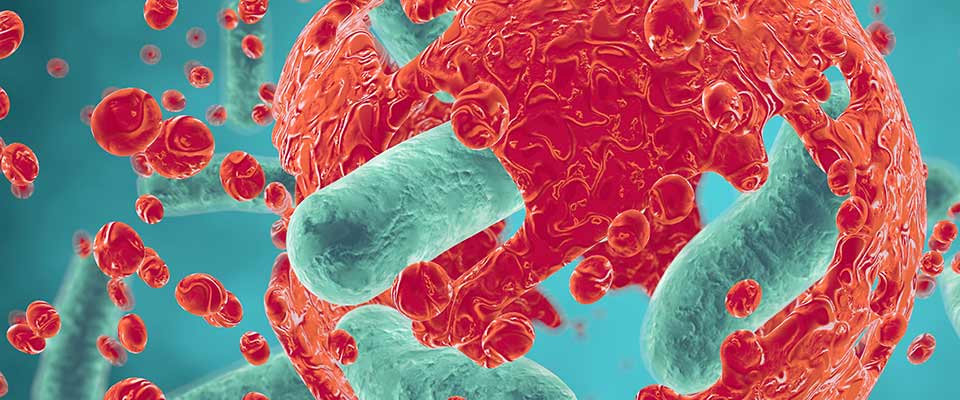
Virology is taught by Dr. Wayne Gray, who spent 27 years at the University of Arkansas Medical School teaching medical and graduate students and conducting research in medical virology. His research interests are in medical microbiology, virology, and vaccines.
![]() Virology introduces students to the basic principles of viruses and virus diseases in human, animals, and plants. Students learn the structure of viruses and the molecular mechanisms by which they replicate in cells. In addition, they learn the pathogenesis and clinical symptoms of viral diseases, how these diseases are treated with antiviral agents, and how they are prevented with vaccines. The course provides a strong infectious disease background for students interested in human health care and veterinary medicine.
Virology introduces students to the basic principles of viruses and virus diseases in human, animals, and plants. Students learn the structure of viruses and the molecular mechanisms by which they replicate in cells. In addition, they learn the pathogenesis and clinical symptoms of viral diseases, how these diseases are treated with antiviral agents, and how they are prevented with vaccines. The course provides a strong infectious disease background for students interested in human health care and veterinary medicine.
“This class is great! Material is pretty cool and relevant, and the tests are fair and relatively easy if you study. TAKE THIS CLASS. Dr. Gray is a very passionate teacher. I learned so much!”
“Dr. Gray is one of the greatest professors that I have had since I have been in college. I recommend you to take his courses if you are interested in going into any healthcare field. It is a very interesting subject matter and he really takes the time you understand the viruses and the diseases they cause making it very applicable to pre-med majors.”

Dr. Carol Britson, a University of Mississippi PLATO Excellence in Teaching Award recipient, offers Human Anatomy for biology and pre-health professions students. This course is more advanced than the Anatomy & Physiology sequence taught for sophomores primarily going into nursing. Laboratory resources in this course provide students with an unparalleled entry into exploration of the structure of the human organism as well as the building blocks for success in professional programs such as medicine, dentistry, physical therapy, physician assistant, etc.
 In the laboratory, students engage in active examination, dissection, and study of “Gloria,” our synthetic cadaver that provides the feel and flexibility of living tissue. Students carry this new knowledge through to examination of our plastinated cadaver prosections and sections (thin 2D slices). Students connect the anatomy of the synthetic cadaver and plastinated specimens to modern technology in the use of 3D visualization software. Students manipulate CT and MRI data from multiple individuals and perspectives to problem solve in the anatomy lab by connecting two dimensions to three, nonliving to the living, and education to professional goals.
In the laboratory, students engage in active examination, dissection, and study of “Gloria,” our synthetic cadaver that provides the feel and flexibility of living tissue. Students carry this new knowledge through to examination of our plastinated cadaver prosections and sections (thin 2D slices). Students connect the anatomy of the synthetic cadaver and plastinated specimens to modern technology in the use of 3D visualization software. Students manipulate CT and MRI data from multiple individuals and perspectives to problem solve in the anatomy lab by connecting two dimensions to three, nonliving to the living, and education to professional goals.
“This has been one of my favorite biology classes that I have taken here at Ole Miss! It is one of the first that I feel will be extremely helpful to me for med school. Do not get me wrong– it is a hard class and needs to be taken in a semester where you could focus on the course!”
“You truly learn anatomy and how to not just memorize material, but to actually learn it. Dr. Britson is very passionate about this subject and teaches with enthusiasm. She is a great teacher that is very passionate about the course and is willing to help with organization strategies that are necessary to be successful in this class.”